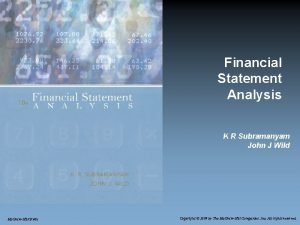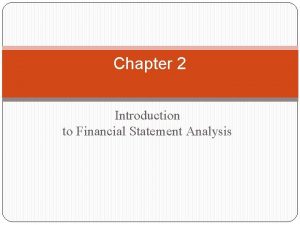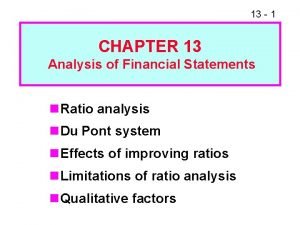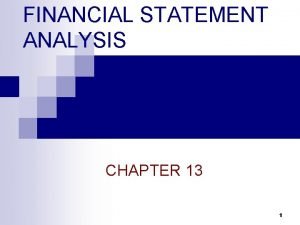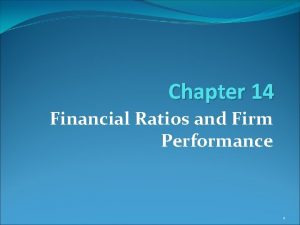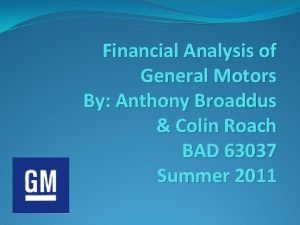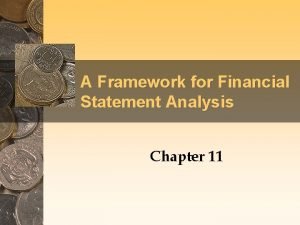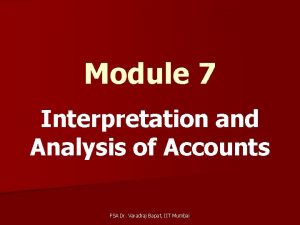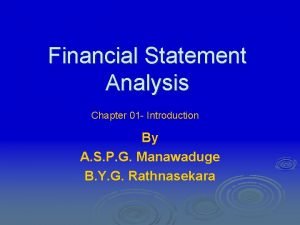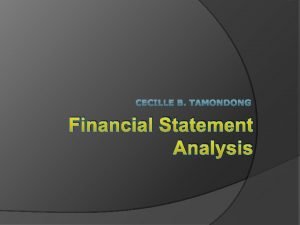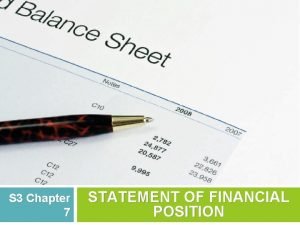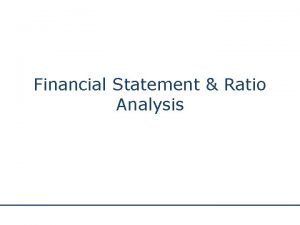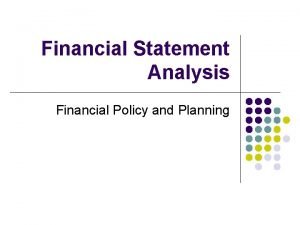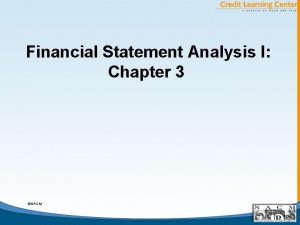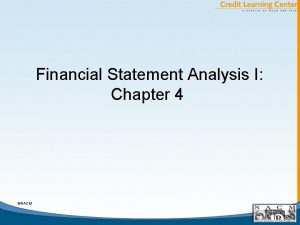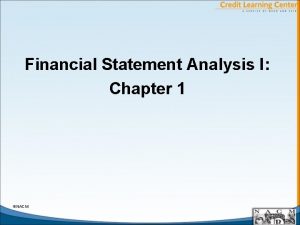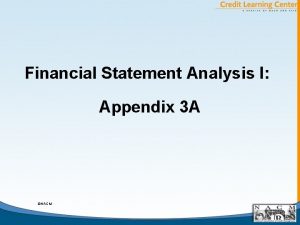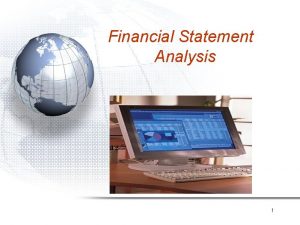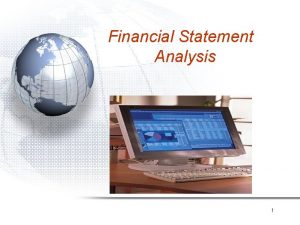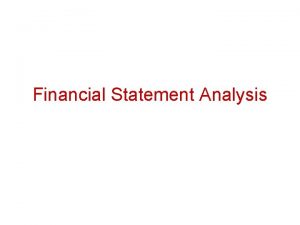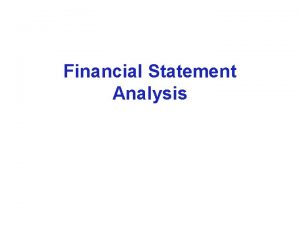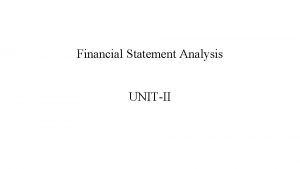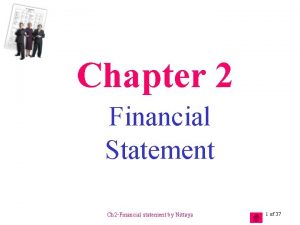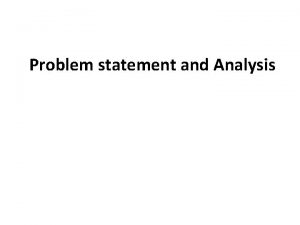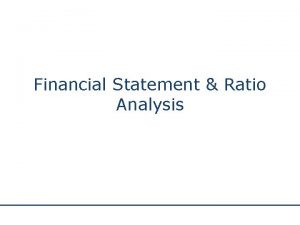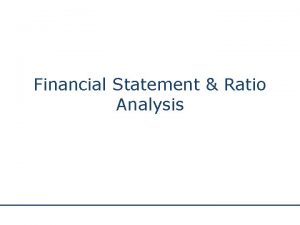Financial Statement Analysis I Chapter 2 NACM General

















- Slides: 17

Financial Statement Analysis I: Chapter 2 ©NACM

General Chapter Notes A. Debtor’s Decisions, An Example: Legal Form of the Debtor 1. What Legal Form Means 2. The Six Typical Forms: Sole Proprietorship, General Partnership, Limited Partnership, LLC, Subchapter S Corp. , Chapter C Corp. B. Forms with Personal Liability for Business Debts: Sole Proprietorship, General Partnership C. Forms with Limited Liability: LLC, Subchapter S and Chapter C Corporations, Limited Partnerships D. Relevance of Business Balance Sheet for Sole Prop. , Part. E. Limited Liability and Guarantees of Account F. Legal Form and Taxes on Business Income Slide 2 -1

General Chapter Notes (continued) G. Liquidity and the Ordering of the Balance Sheet H. Public Reporting Accounting and Tax Accounting I. Going Concern Value, Market Value, Book Value, and Liquidation Values for Assets J. Assets Outside of the Balance Sheet K. Information on the Priority and Security Position of Liabilities L. Liquidity and the Operating Cycle (see next slide) Slide 2 -2

Cash Flows of the Firm Slide 2 -3

Notes for Particular Parts of Chapter 2 A. Consolidation B. Fiscal Year-end Dates C. Introduction to Trend Analysis D. Common Size Statements Slide 2 -4

Notes for Particular Parts of Chapter 2 (continued) E. Marketable Securities and Why Firms Hold Them F. Accounts Receivable G. Inventory 1. The importance of inventory investment 2. Why firms hold finished goods inventory 3. LIFO, FIFO, and actual inventory practice 4. Inventory accounting and price levels H. Taxes, Inventory Accounting, and Cash Flow I. PP&E, Depreciation, Amortization, and Market Value J. Other Assets Slide 2 -5

Notes for Particular Parts of Chapter 2 (continued) K. L. M. N. O. P. Accounts Payable Current Maturities of Long-Term Debt Accrued Liabilities Deferred Income Taxes and Depreciation Long-Term Debt Capital Leases, Operating Leases, Owned Assets, and the Balance Sheet Q. Preferred Stock R. The Three Common Equity Accounts 1. The three accounts defined 2. Where retained earnings go 3. Book equity versus market value 4. Relevance of equity value for trade creditors Slide 2 -6

Problem 2. 11 Public Accounting Tax Accounting Revenue $800, 000 Other Expenses $350, 000 Depreciation $130, 000 $200, 000 Earnings Before Taxes $320, 000 $250, 000 Tax Bill (34% of EBT) $108, 800 $85, 000 Increase in Deferred Taxes $23, 800 Slide 2 -7

Problem 2. 14 a Inventory in order of purchase: Units x Cost 600 x $10 = 1, 000 x 11 = 900 x 12 = 700 x 14 = 3, 200 Beginning inventory First purchase during the year Second purchase during the year Third purchase during the year Total = Total $ 6, 000 11, 000 10, 800 9, 800 $37, 600 Sales for the year = 1, 900 units Ending inventory = 3, 200− 1, 900 = 1, 300 units Total for new inventory purchases: $37, 600−$6, 000 = $31, 600 Slide 2 -8

COGS and Inventory Balance using Weighted Average Cost per Unit: Weighted average cost = $37, 600/3, 200 = $11. 75 per unit COGS = $11. 75 x 1, 900 units = $22, 325 Ending inventory balance = $11. 75 x 1, 300 units = $15, 275 Slide 2 -9

COGS and Inventory Balance using FIFO: COGS calculation: 600@$10 = $6, 000 entire beginning inventory 1, 000@$11 = $11, 000 entire first purchase 300@$12 = $ 3, 600 partial from second purchase Total COGS $20, 600 Remaining at $12 per unit from second purchase: 900 -300 = 600 units Ending Inventory: 600@$12 = $ 7, 200 remaining from second purchase 700@$14 = $ 9, 800 entire third purchase Total $17, 000 Slide 2 -10

COGS and Inventory Balance using LIFO: COGS calculation: 700@$14 = $ 9, 800 entire third purchase 900@$12 = $10, 800 entire second purchase 300@$11 = $ 3, 300 partial from first purchase Total COGS $23, 900 Remaining at $11 from first purchase: 1, 000− 300 = 700 units Ending Inventory: 600@$10 = $ 6, 000 entire beginning inventory 700@$11 = $ 7, 700 remaining from first purchase Total $13, 700 Slide 2 -11

Problem 2 -11 parts b, c, and d Contrast of three inventory accounting methods Method Weighted Average FIFO LIFO COGS $22, 325 $20, 600 $23, 900 Ending Inventory $15, 275 $17, 000 $13, 700 Actual cash outflow for purchasing inventory: $31, 600 (does not depend on accounting method chosen) Reduction in taxes from using LIFO over FIFO: $23, 900−$20, 600 = $3, 300; $3, 300*0. 34 = $1, 122 a cash flow savings Slide 2 -12

Problem 2. 18 Dean Corporation Year 2008 Beginning Retained Earnings Net Income End Ret. Earns. , no Dividends Act. Ending Ret. Earnings Cash Dividends $700 $890 $1, 045 $250 $225 $40 $950 $1, 115 $1, 085 $890 $1, 045 $1, 010 $60 $75 Slide 2 -13 2009 2010

Problem 2. 19 Balance Sheet at December 31, 20 XX Assets Current Assets Cash Accounts receivable Inventory Prepaid expenses Total Current Assets Property, plant and equipment 34, 000 Less accumulated depreciation (10, 500) Net property, plant and equipment Land held for sale (an Other Asset) Total Assets Slide 2 -14 $1, 500 6, 200 12, 400 700 $20, 800 $23, 500 $9, 200 $53, 500

Problem 2. 19 (continued) Liabilities and stockholders' equity Current liabilities Accounts payable Notes payable Accrued interest payable Current portion of long-term debt Total current liabilities Deferred taxes payable Bonds payable Total liabilities Slide 2 -15 $4, 300 8, 700 1, 400 1, 700 $16, 100 1, 600 14, 500 $32, 200

Problem 2. 19 (continued) Stockholders' equity Common stock Additional paid-in capital Retained earnings Total stockholders' equity Total liabilities and stockholders' equity $2, 500 7, 000 11, 800 21, 300 $53, 500 Calculation of Retained Earnings: $53, 500−$32, 200−$2, 500−$7, 000 = $11, 800 Current Ratio = Total Current Assets/ Total Current Liabilities = $20, 800/$16, 100 = 1. 29 Slide 2 -16
 Chapter 14 financial statement analysis solutions
Chapter 14 financial statement analysis solutions Financial statement analysis subramanyam
Financial statement analysis subramanyam Chapter 14 financial statement analysis solutions
Chapter 14 financial statement analysis solutions Chapter 2 financial statement analysis solutions
Chapter 2 financial statement analysis solutions Chapter 13 financial statement analysis
Chapter 13 financial statement analysis Analysis of financial statements
Analysis of financial statements Chapter 1 overview of financial statement analysis
Chapter 1 overview of financial statement analysis Chapter 14 financial statement analysis
Chapter 14 financial statement analysis General motors mission statement
General motors mission statement Factors affecting financial statement analysis
Factors affecting financial statement analysis Financial statement analysis objectives
Financial statement analysis objectives Vertical analysis interpretation
Vertical analysis interpretation Introduction of financial statement analysis
Introduction of financial statement analysis Banking financial statement analysis
Banking financial statement analysis What is vertical financial statement analysis
What is vertical financial statement analysis Limitations of financial statement analysis
Limitations of financial statement analysis Average payment period ratio
Average payment period ratio Financial statement analysis and planning
Financial statement analysis and planning

